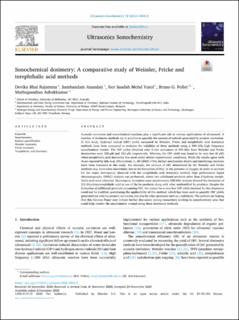| dc.contributor.author | Rajamma, Devika Bhai Rajamma | |
| dc.contributor.author | Anandan, Sambandam | |
| dc.contributor.author | Yusof, Nor Saadah Mohd | |
| dc.contributor.author | Pollet, Bruno | |
| dc.contributor.author | Ashokkumar, Muthupandian | |
| dc.date.accessioned | 2022-12-02T08:26:49Z | |
| dc.date.available | 2022-12-02T08:26:49Z | |
| dc.date.created | 2021-01-19T07:58:56Z | |
| dc.date.issued | 2021 | |
| dc.identifier.citation | Ultrasonics sonochemistry. 2021, 72 . | en_US |
| dc.identifier.issn | 1350-4177 | |
| dc.identifier.uri | https://hdl.handle.net/11250/3035537 | |
| dc.description.abstract | Acoustic cavitation and sonochemical reactions play a significant role in various applications of ultrasound. A number of dosimetry methods are in practice to quantify the amount of radicals generated by acoustic cavitation. In this study, hydroxyl radical (OHradical dot) yields measured by Weissler, Fricke and terephthalic acid dosimetry methods have been compared to evaluate the validities of these methods using a 490 kHz high frequency sonochemical reactor. The OHradical dot yields obtained after 5 min sonication at 490 kHz from Weissler and Fricke dosimetries were 200 µM and 289 µM, respectively. Whereas, the OHradical dot yield was found to be very low (8 µM) when terephthalic acid dosimetry was used under similar experimental conditions. While the results agree with those reported by Iida et al. (Microchem. J., 80 (2005) 159), further mechanistic details and interfering reactions have been discussed in this study. For example, the amount of OHradical dot determined by the Weissler and Fricke methods may have some uncertainty due to the formation of HO2radical dot in the presence of oxygen. In order to account for the major discrepancy observed with the terephthalic acid dosimetry method, high performance liquid chromatography (HPLC) analysis was performed, where two additional products other than 2-hydroxy terephthalic acid were observed. Electrospray ionization mass spectrometry (ESI-MS) analysis showed the formation of 2,5-dihydroxyterephthalic acid as one of the by-products along with other unidentified by-products. Despite the formation of additional products consuming OHradical dot, the reason for a very low OHradical dot yield obtained by this dosimetry could not be justified, questioning the applicability of this method, which has been used to quantify OHradical dot yields generated not only by acoustic cavitation, but also by other processes such as γ-radiolysis. The authors are hoping that this Opinion Paper may initiate further discussion among researchers working in sonochemistry area that could help resolve the uncertainties around using these dosimetry methods. | en_US |
| dc.language.iso | eng | en_US |
| dc.publisher | Elsevier | en_US |
| dc.rights | Attribution-NonCommercial-NoDerivatives 4.0 Internasjonal | * |
| dc.rights.uri | http://creativecommons.org/licenses/by-nc-nd/4.0/deed.no | * |
| dc.title | Sonochemical dosimetry: A comparative study of Weissler, Fricke and terephthalic acid methods | en_US |
| dc.title.alternative | Sonochemical dosimetry: A comparative study of Weissler, Fricke and terephthalic acid methods | en_US |
| dc.type | Peer reviewed | en_US |
| dc.type | Journal article | en_US |
| dc.description.version | publishedVersion | en_US |
| dc.source.pagenumber | 6 | en_US |
| dc.source.volume | 72 | en_US |
| dc.source.journal | Ultrasonics sonochemistry | en_US |
| dc.identifier.doi | 10.1016/j.ultsonch.2020.105413 | |
| dc.identifier.cristin | 1873851 | |
| cristin.ispublished | true | |
| cristin.fulltext | original | |
| cristin.qualitycode | 1 | |

